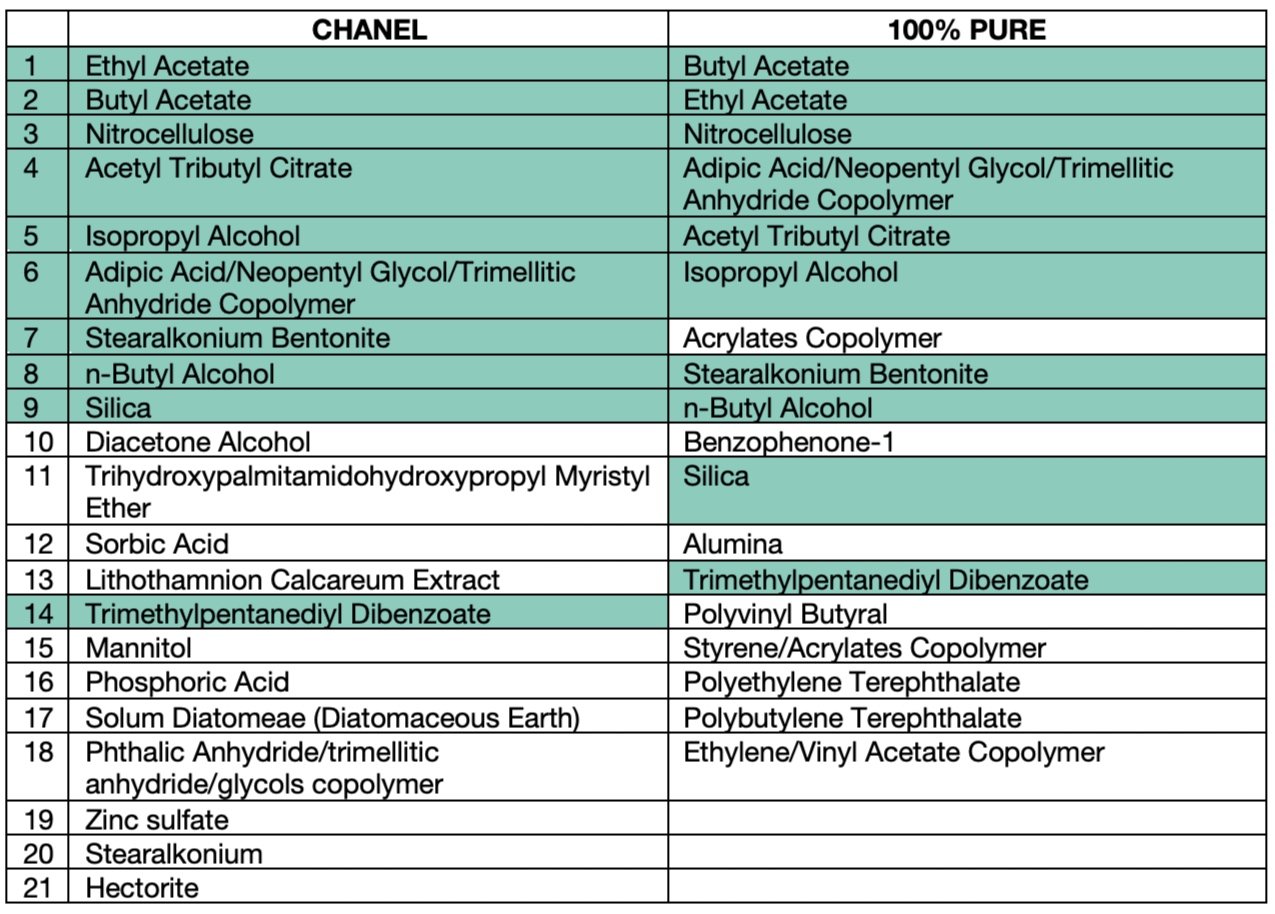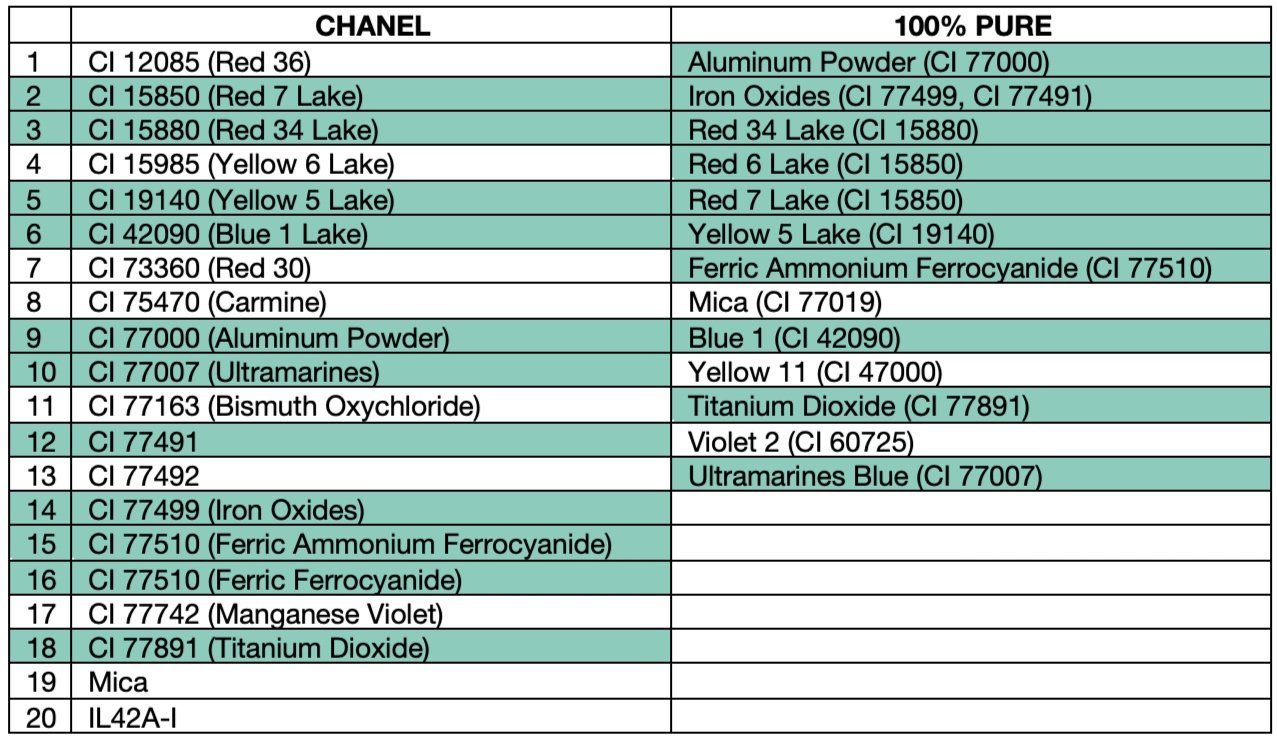Chanel vs Purity: Lacquered in A Sea of Murky Green
NON-TOXIC POLISH
THE JOKE CONTINUES.
Ever feel lost treading through the sea of inundating scientific evidence about our daily routines? One week caffeine is great for our hearts, the next it’s shortening our telomeres. Striving for the best in natural beauty becomes complicated when we can’t decipher the difference between natural-promoting and regular brands.
A decade ago I evaluated how pure 100% Pure was and compared their formula to regular brands like Chanel. Fast-forward to this post-yet-still pandemic summer when nails are so big that nail polish brands clamor to stand out. Chanel is Chanel, so they need to do very little with their always in-demand beauty line. Sea Sea Green, part of their summer pastel line, sold out before gaining traction. Huefully comparable is Matcha Milk Tea by the vegan, natural-asserting 100% Pure.
Over a 10 year period, the basic formulation between these brands has remained. This emphasizes the challenge of “natural” brands to innovate a truly natural, customarily connotating non-toxic, nail polish. Pure expanded from a 10-free formula to claims that their nail polish is “without the 20 common toxins found in conventional formulas”. Chanel uses a conventional base formula that does not include the “toxic” chemicals referenced by Pure. It turns out that some ingredients in “natural” formulations are actually toxic. Factoring in the definitions of common toxins and conventionality can help navigate murky waters.
Formulation:
The Basic 3:
Chanel shares 10 basic formulation ingredients with Pure. The mainstays in all polishes are the acetates (butyl and ethyl) and nitrocellulose. Since Pure avows “fruit pigmented” cosmetics, their butyl acetate (BA) is likely derived from red apples than cheese, and their ethyl acetate (EA) from spoiled wine. It is unclear if Chanel uses the same natural sources or produces EA using ethanol (sugarcane and petroleum) and acetic acid (vinegar and herbicides). As the rule goes for wine, a little is fine due to its natural occurrence, but overexposure can be toxic. After all, researchers use EA to sedate insect specimens. Acetates, which are necessary to dissolve the nitrocellulose, still produce a burning of the eyes, throat and nose when applying several coats of polish. The sting was unnoticeable for Chanel, but overwhelming for Pure. Also, because BA uses butanol with acetic and sulfuric acids, it can irritate the skin. It is a component of honeybee pheromones, and bee stings hurt, right?
The Others (Add-Ins):
Both brands use phthalic anhydride/trimellitic anhydride/glycols copolymer (Table 1), which rarely causes allergic reactions when added to nail polish as an “anti-crackler”. Sometimes the potential toxicity of an ingredient can be cancelled out with a neutralizing* agent. It is unclear if the use of copolymers from fruits (pineapples, raspberries) overrides potential damage from Pure’s use of BP-1 (see Color). This is a point of concern since the endocrine disruptor appears at a higher concentration. Also, despite Pure possibly sourcing styrene/acrylates copolymer (Table 1) from cinnamon and coffee, it can also come from the “forbidden” toxic nail polish ingredient toluene. Either way, the chemical is a carcinogen.
Chanel aptly attributed the sea by adding a seaweed extract from Lithothamnion calcareum. Although L. calcareum is used in clinical settings to treat osteoarthritis, any putative benefits to alpha-keratin-filled nails is uncertain. However, they use a fossilized microalgae (Solum Diatomeae) as a silica source, which is known to fortify brittle nails. But, it’s also a natural pest repellent so maybe when wearing this will fend off arthropods like bed bugs.
The Color:
Pure shares 10 color ingredients with Chanel, but cacti lice, carmine, is not one (Table 2). Cochineal extract may rarely cause allergic reactions, but it is not a known endocrine disruptor like benzophenone-1 (BP-1). Pure adds BP-1 to prevent color fading under UV. Unfortunately, benzophenones disrupts the endocrine system and is linked to rapid growth, multiplication and spread of breast cancer and ovarian cancer cells**.
Results: Chanel wins based on overall less toxic ingredients and the addition of fortifying ingredients.
Other Considerations
Cost:
Chanel $30
Pure $12
Results: Depends on your wallet, but tipping toward Chanel for the value on higher quality ingredients.
Pigmentation:
Chanel was very light and Pure greener, but both are nice pastels.
Results: Both win.
Application:
Chanel’s application was thinner than Pure’s and each needs layering. Two coats of Pure went on smooth and thick, but not overwhelming so as to produce a sticky mess. Four coats of Chanel provided a clean finish. Pure’s wider brush imparts a more uniform application.
Results: Pure wins.
Wear:
Chanel wore for about a week, but the chipping occurred during heavy use and washing from Day 1. Pure lasted for the same amount of time with and without base and top coats.
Results: Both need work.
Drying Time:
Both are fast drying at approximately 15 minutes.
Results: Pure wins based on the ability of a thick formula to dry fast.


Bottom Line:
Chemical properties are usually the same despite their origination. Unfortunately, some gorgeous Instagrammable seas and teas can also be polluted. Sometimes using a pure-boasting brand boosts the conscience more than health. After all, acetates and fruit flies emanate from fruit. Exclusive of a packaging overhaul, which now resembles Ten Over Ten’s, Pure has taken 10 years to basically be in the same spot. So, as written back then, non-toxic nail polish is a joke.
Notes:
*not the same as pH neutralizing, but not excluded
**These studies have been done in labs and not in people.
Science in the context of culture
It’s every where and every day.








